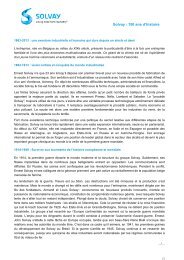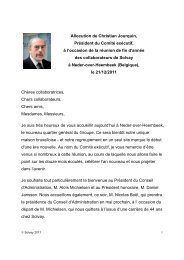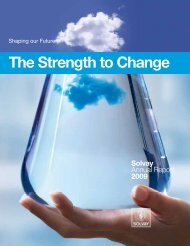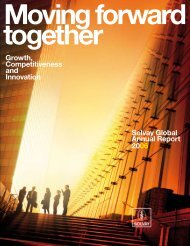solvay_live243_p02a04 somEdito
solvay_live243_p02a04 somEdito
solvay_live243_p02a04 somEdito
Create successful ePaper yourself
Turn your PDF publications into a flip-book with our unique Google optimized e-Paper software.
Dossier<br />
Epicerol<br />
101301<br />
62<br />
EPICEROL: SOLVAY SPEEDS UP<br />
THANKS TO GREEN BIOFUEL!<br />
USING A SUB-PRODUCT<br />
OF BIO-DIESEL<br />
SolvayInnovationTrophy2006<br />
Solvay has developed a new process<br />
that has been named Epicerol, which<br />
is based on the transformation of glycerine,<br />
a by-product of the bio-diesel industry.<br />
Epichlorhydrine was used to produce glycerine.<br />
The innovation consists of inversing<br />
the reaction and use the glycerine to produce<br />
epichlorhydrine. The development of the<br />
glycerine based process for the production<br />
of epichlorhydrine has been the subject of 17<br />
patent applications by Solvay. The ever growing<br />
demand for epichlorhydrine, whose main<br />
applications are the production of epoxy resins,<br />
the reinforcement of paper and the purification<br />
of water, are set to exceed the world-wide<br />
production capacities between now and 2010.<br />
Within the framework of the Epicerol process,<br />
the glycerine – a renewable product – takes<br />
the place of propylene, a hydrocarbon. Among<br />
its environmental benefits we can name the<br />
reduction in chlorine by-products, as well as a<br />
significant reduction in water consumption.<br />
The first Epicerol production unit will be<br />
started up in Tavaux (France) in 2007. A second<br />
unit is on the cards for Rheinberg (Germany)<br />
in 2008. Finally, as bio-diesel is an alternative<br />
to fuel, even larger units are being studied<br />
for Asia, Europe and the United States.<br />
The creation of a trademark seals the reputation<br />
of this process, and should shore up its<br />
communication.<br />
> Bruno Jestin; Patrick Gilbeau; Philippe Jacques;<br />
Philippe Krafft.<br />
> SBU EDS<br />
104594 102216<br />
USD 298 MILLION CONTRACT FOR CELL-BASED<br />
PANDEMIC INFLUENZA VACCINE<br />
SOLVAY CONSOLIDATES<br />
ITS LEADERSHIP POSITION,<br />
BOTH IN THE USA<br />
AND WORLD-WIDE<br />
On the 21st of June 2005, after only eight<br />
weeks of intense preparation by a multifunctional<br />
team, Solvay submitted a 700 page<br />
tender to the United States Department of Health<br />
and Human Services (DHHS) in response to its call<br />
for the development and registration of<br />
a cell-based influenza vaccine as well as for the<br />
construction of a production plant in the United<br />
States, capable of producing 150 millions doses<br />
within six months, in the case of a pandemic.<br />
After going through the first selection phase,<br />
Solvay was still in the running with three other<br />
pharmaceutical groups. On the 4 th of May 2006,<br />
Solvay Pharmaceuticals announced the conclusion<br />
of a five year contract with the DHHS for a total<br />
amount of USD 298 million, the biggest share<br />
of the one billion US dollars allocated for this<br />
project, and shared out among the four<br />
short-listed companies. This success is a reflection<br />
of the know-how that we have accumulated over<br />
the past 50 years in influenza vaccines and<br />
of the quality of our new cell culture technology<br />
in the field. It is also the result of the first-rate<br />
involvement of the Solvay staff working in this<br />
Sector who were able to draw lessons from<br />
previous tenders, put together an excellent team<br />
effort and demonstrate flexibility and creativity<br />
in face of the DHHS demands and thus protect<br />
the human race against influenza pandemics.<br />
> Andrew Stevenson; Darya Aberback; Sandra Allen;<br />
Wil Cramer; Curtis Dale; Iris Debruijn;<br />
Mike Dornhecker; Laurie Downey; Michael Emery;<br />
Ed Geuns; Michael Hare; Neil Hirsch; Joanne Kearney;<br />
John Keeshen;Alex Kersten; Sjirk Kok; Patroski Lawson;<br />
Dorine Leyssius; Jeroen Medema; Gerard Rigter;<br />
Pieter Rouwette; Maryellen Schnell; Harold Shlevin;<br />
Jennifer Thurber; Herbert Vanderstrate; Herman<br />
Van Heemstra; Friso Vanvoorthuizen;Thomas Wijnands.<br />
> PHARMACEUTICALS SECTOR<br />
I-CARE INTEGRATES PRODUCT SAFETY,<br />
PEOPLE SAFETY AND OCCUPATIONAL HEALTH<br />
TRANSVERSAL AND<br />
VERTICAL INFORMATION<br />
MANAGEMENT<br />
In this age that is witnessing the globalisation<br />
of business and the widespread circulation<br />
of products, the information relating to health and<br />
environmental risks and to risk prevention must<br />
be reliable, available at any times and in any place<br />
and in forms - often defined by law - that are<br />
adapted to a wide range of publics: clients,<br />
authorities, users and producers, experts, etc.<br />
Within the Group, safely managing a given<br />
product is always the combined responsibility of a<br />
string of experts. To consolidate their know-how<br />
and the information on regulatory obligations,<br />
both for the chemicals used and manufactured in<br />
our plants, the information systems need to be<br />
highly integrated. I-Care makes it possible to<br />
transversally manage – between experts from<br />
several disciplines – and vertically manage –<br />
throughout the Group’s entities – all this<br />
information, whether toxicological,<br />
environmental, technical or relating<br />
to the maze of laws and regulations to be<br />
respected. It also integrates the information on<br />
each type of technical equipment. Finally,<br />
combining this information on the products and<br />
the health monitoring of the personnel, I-Care<br />
makes it possible to manage the data about the<br />
exposure of workers at their workstation and<br />
consolidated medical data such as the bio-<br />
monitoring of possible effects on health. I-Care is<br />
widening its focus to combine data from all these<br />
sources, making it today a model for the entire<br />
chemical industry.<br />
> Pierre Coërs; Willy Asnong; Christiane Baleux;<br />
Luc Barbeaux; Christine Defourny; Laurence Fievet;<br />
Andreas Georg; Eric Moens; Gerhard Neuenfeldt;<br />
Thomas Paschek; Jack Smit; Jacques Vanalsenoy;<br />
Paul Vanhemelryck.<br />
> CC HSE


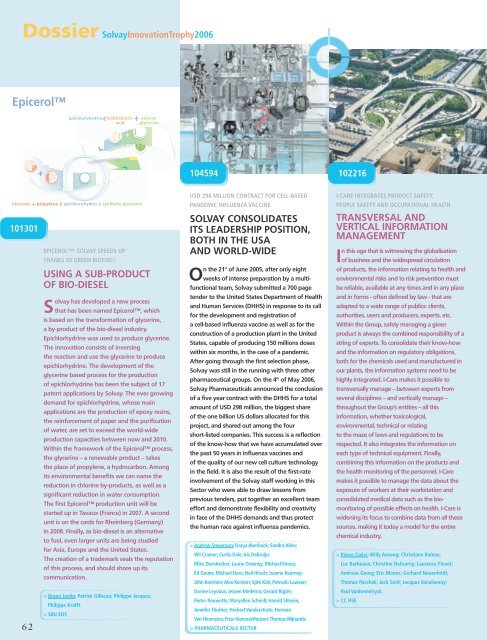

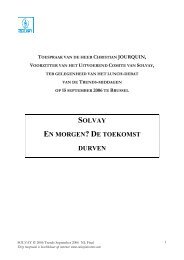
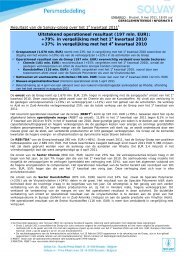

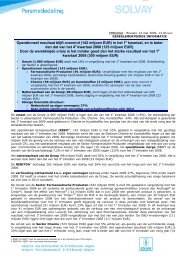
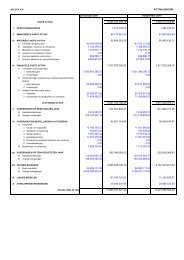

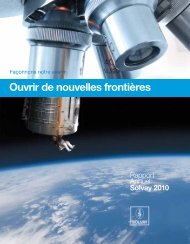
![PROC.1 [LETTRE] - Solvay](https://img.yumpu.com/16585746/1/184x260/proc1-lettre-solvay.jpg?quality=85)
